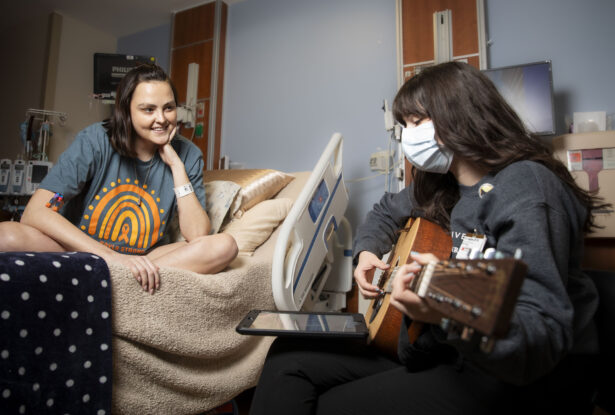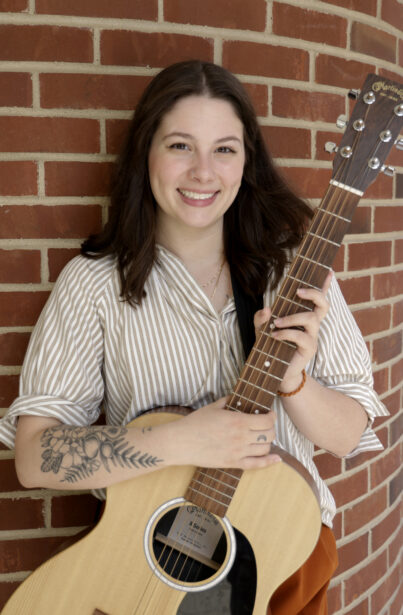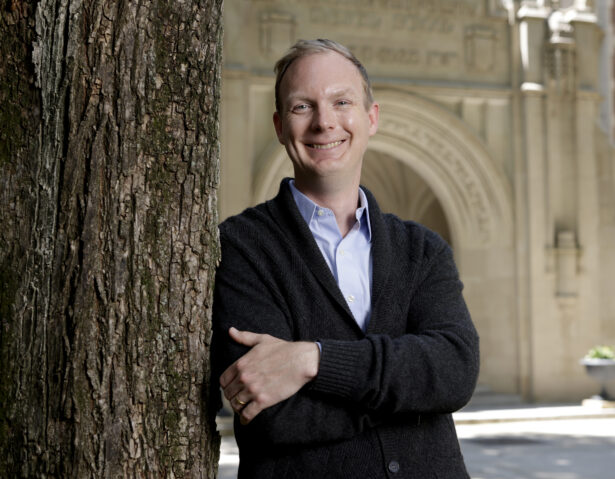High Notes
Music therapy uplifts patients
August 6, 2024

It’s a quiet March day on the hematology/oncology floor at Vanderbilt University Hospital (VUH), and the calming sounds from an acoustic guitar are trickling out of Kayla Kidney’s room.
Inside the room, Kidney, a Nashville, Tennessee, nurse who was diagnosed with acute lymphoblastic leukemia (ALL) in February, sat cross-legged on her hospital bed. Tori Langham, one of two board-certified music therapists employed at Vanderbilt University Medical Center (VUMC), sat in a chair beside Kidney’s bed, strumming her guitar and singing a beautiful song, “Desert Butterfly.”
“I refuse to worry. I will only be still. Though the seasons may change. Through the drought and the rain. I will keep on flying high, desert butterfly.”
But this is more than just a simple ballad played for a patient.
Kidney, 28, and Langham were putting the finishing touches on the song written by Kidney, her fiancé, Adam Newton, and her father, Kris. The lyrical ballad, sung and recorded by Langham, was played at Kidney and Newton’s small lakeside wedding in May.
It represents transformation, the love between Kidney and Newton, and the detour they’ve had to make around her illness. The title and refrain are also a meaningful nod to butterflies and the desert, two things that mean a lot to Kidney, a native of Arizona.
Building a rapport
In February Kidney was deep into planning her May 18 wedding when she started feeling unwell.
“After a couple of weeks of ignoring some signs and symptoms, I just chalked it up to not being a big deal,” she said.
But during the night on Feb. 22, she woke up with chest pain. She was taken to the hospital, tests were run, and she was diagnosed with ALL, a fast-growing cancer of the blood and bone marrow.
“It was pretty surreal,” she said.
Suddenly, finalizing the wedding of her dreams took a back seat to a three-week hospitalization at Vanderbilt and devising a plan to rid her body of ALL.
Weeks spent in a hospital can be grueling and anxiety inducing. Not only did Kidney’s body need to heal, but so did her mind.
Shortly after Kidney’s admission, a hospital chaplain and nurse sent a request for a consult to the music therapy program, which focuses on the use of music to help with pain management, physical rehabilitation, psychosocial support, procedural support, and coping with hospitalization and disease.

– Kayla Kidney, pictured above below with Tori Langham
Within days Langham visited Kidney, and the two quickly built a rapport.
Sitting in on the collaborative writing of her wedding song was Sean Anderson, a chaplain resident in VUMC’s Clinical Pastoral Education program, who baptized Kidney the first week she was in the hospital and would be officiating at her wedding.
“Once the wedding is over, I’ll be taking my Amazon wedding dress off and putting a bathing suit on, and we’ll be on the lake,” Kidney said. (She and Newton have rescheduled their larger wedding for May 31, 2025.) “I don’t want to miss out on wearing my big dress,” she said, smiling.
Establishing a connection
Music therapy has been formalized as a professional field for more than 70 years. It has been available for pediatric patients for nearly 20 years but is relatively new to the adult patient population at VUMC.
Music therapists use evidence-based research protocols involving music and music-making, personalized to a patient’s clinical needs and goals. It’s not a one-size-fits-all approach. Sessions range from 15 minutes to two hours.
At VUMC, the music therapist meets with a patient after receiving a referral from a member of the patient’s treatment team.

“I go in and assess. I don’t just go in and play (music),” said Langham, whose position is funded through VUMC’s Department of Medicine. “I establish a connection with the patient, and we do things together to help them reach specific goals while hospitalized. We may write a song. We may need to build some rapport. We may work with physical therapy or occupational therapy to reach physical rehabilitation goals. Or our goal may be minimizing pain and discomfort. Maybe they aren’t able to write a song, but they can express themselves in choosing songs. We figure out what is best for the patient.
“Our goal is to improve the patient’s experience,” Langham said. “Our program has been having a remarkable impact. We are not just helping our patients, but staff as well. We all need support and to know what we are doing matters.”
After the successful pilot of the program for adults at VUMC in 2022, music therapy was expanded to three additional units at VUH, including hematology/oncology and palliative care. The music therapy program at Monroe Carell Jr. Children’s Hospital at Vanderbilt continues to thrive and now employs three board-certified music therapists.
Emily Owens, a music therapist in the adult hospital since February, is leading a six-month pilot which offers increased access to music therapy in two inpatient oncology units.
Owens said there were many roads that led to her becoming a music therapist.
“Two of my absolute favorite aspects about music are its ability to connect us to one another and how music allows us to communicate our inner emotions in ways that words may fail to wholly encompass. Music therapy has given me the opportunity to bridge my love and lifetime dedication to music and my interest in science and psychology along with my passion for helping others,” Owens said.
Langham said a personal experience led to her pursuing music therapy as a career.
“I’ve always loved music and the healing power of music,” Langham said. “I felt like if there was a way I could use it in a purposeful manner, I wanted to do that,” she said, adding that she became intrigued when her grandfather had a stroke and could sing, but couldn’t speak. “I found out later through music therapy that it’s because music uses an entirely different part of the brain. He was able to sing things he couldn’t speak.”
Owens has also received additional training in neurologic music therapy, which uses standardized and evidence-based techniques specifically for nonmusical goals related to functional rehabilitation and neurorehabilitation.
“Research has demonstrated that the therapeutic application of music can help create new neural pathways in the brain related to cognition, movement, communication and psychosocial function,” Owens said. “Music affects our entire brain, and we can use different facets of music, such as rhythm, lyrics of preferred songs, and melody, to access different parts of our brain for specific rehabilitation goals.”
Langham said data shows when music therapy is working.
Music therapy in oncology care can address, but is not limited to, nonpharmacological pain management or perception of pain, helping patients develop music-based coping skills, functional rehabilitation goals, and providing an outlet for emotional and creative self-expression.
Both Owens and Langham work with patients who have cancer. For most patients there are many unknowns and often a lot of anxiety that music can help control, Langham said. “Maybe someone has just gotten a new diagnosis, and they don’t know how long they’re going to be in the hospital. Music can help them cope. It can also help relax and distract patients from any discomfort they are having with chemotherapy,” she said.
“Sometimes this may look like a patient and myself improvising on instruments together,” Owens said. “However, the goals that we’re working on could be enhancing fine motor skills, recording a soundscape for the patient to listen to when they’re feeling anxious or distressed, or for nonverbal expressive communication and emotional expression goals.”
Those pursuing certification as a music therapist need to complete an undergraduate degree in music therapy and 1,200 clinical hours including a full-time internship that usually lasts about six months. Following that, they must sit for an exam to be certified by the Certification Board for Music Therapists. This extra training and certification set music therapists apart from others using music in clinical spaces and help ensure their interventions are not only effective, but also safe for patients.
“When we go back and look at the data, it’s not just ‘Oh, wow, I think I helped this person,’” she said. “There is proof. I’ve seen heart rates go down on heart monitors when I’m working with a patient.” A recent study in VUMC’s trauma step-down unit showed a significant decrease in patients’ pain and anxiety scores.
Humanities and medicine
Andy Wooldridge, MD, assistant professor of Medicine at VUMC, advocates for the adult music therapy program at VUMC through his role as program director of Arts and Humanities in Healthcare for the Department of Medicine.

“It grew out of my work in palliative care and supporting people with serious illnesses, including cancer, in all the ways we can,” Wooldridge said. “Our overall vision is to enhance the well-being on all levels at VUMC through the arts and humanities, and improving the patient’s experience with music therapy is a cornerstone of this broad initiative. Our patients and families have said that music therapy provides a unique dimension of healing when they come to our hospital. It heals in a different way than any of the other care we provide,” he said.
“The arts are powerful tools for healing,” Wooldridge said. “They are somewhat ancient because we’ve been healing each other with art and music since the dawn of humanity, but also modern and innovative because the more we study music and art therapy and other creative arts therapies combined with advances in our understanding of how the brain works, the more uses we will find for how to help patients with these powerful therapeutic tools.”
Wooldridge said he had little exposure to medical humanities until his palliative care fellowship where he met a music therapist.
“I realized that music therapy was the next cornerstone I wanted to lay in terms of expanding programs in our department,” he said.
Adding the humanities to healing is becoming more widespread at VUMC.
Wooldridge and other health care providers and trainees have participated in healing arts workshops at the Frist Art Museum, and he also led a medical student elective that uses poetry therapy, reflective writing and art therapy.
Of the patient populations studied in music therapy, there is a huge amount of evidence regarding cancer patients, Wooldridge said. “Many studies show improved physical symptoms, such as pain or shortness of breath, or improved psychological support through anxiety management, coping, processing, grieving and normalizing,” he said.
The Esen and Cano Ozgener Fund for the Healing Arts has helped provide creative outlets and therapeutic arts activities at Vanderbilt-Ingram. Owens’ position is funded through this fund. Wooldridge said he hopes that additional funding can be secured in the community to hire additional music therapists to expand into other areas of the hospital.
Wooldridge recalls a recent conversation with a nurse case manager about Langham’s impact on a patient. “She said she was so inspired seeing how impactful music therapy was for a patient in our unit. She said reading the chart about what Tori did and how positive it was for the patient nearly brought her to tears.”
Desert butterflies
When Kidney, Newton and her father sat down with Langham to write the words to her wedding song, Kidney’s father suggested the theme of butterflies because Kidney has always loved them.

Wooldridge said his role with the music therapy program varies. He recently accompanied Langham and Owens to the Tennessee State Legislature to advocate for state licensure for music therapists so their profession can become more recognized. A music therapy certificate was signed into law on May 28. Similar to a license, the Certified Professional Music Therapist provides title and scope of practice protection for music therapy and will serve to increase consumer access to safe and competent music therapy services.
Growing up in Arizona, she loved to watch Monarch butterflies, which are plentiful between April and October. As a child she had a favorite pair of shorts decorated with butterflies that her mother had a hard time getting off her to wash, and her bedroom was wallpapered with pastel butterflies.
“Sometimes I’m hands-on, coordinating. Sometimes I’m helping, advising, cheerleading, facilitating, breaking down barriers and helping to obtain resources.”
“Butterflies have just always been my thing,” she said.
When she was admitted to the hematology/oncology unit on the 10th floor, she discovered it had a butterfly theme. “They’re known for their transformative nature, and many people on this floor are getting bone marrow transplants. Their body changes. Their blood type can change. It’s a transformation,” Kidney said.
Langham said that writing the wedding song helped Kidney express herself while she was hospitalized.
“Sometimes a patient just can’t put their feelings into words, but with music we can make more sense of what’s going on.”
Music therapy and writing her wedding song helped Kidney with anxiety and gave her autonomy and control, Langham said. “Talking about her love story was a way to get her feelings out. I gave her choices. She chose the different vibes, how it sounded. She made all the decisions. It was something for her to do, to look forward to and reflect.”
Kidney is no stranger to music therapy. She’s seen it in action in her job as a nurse.
“I feel like it (being the recipient of music therapy) was something unexpected. I’ve seen it, but I’ve never experienced it from a patient standpoint. There’s something special about the raw, authentic sound of the guitar. It’s peaceful, soothing and distracting. You’re using a different part of your hearing to hear the music versus all the other noises going on around you in the hospital.”
As Kidney and Langham collaborated on the song in March, they worked through some options on sound. Langham recorded a few lines of harmony to blend with what she had already recorded, and the two discussed adding piano to the acoustic guitar in the song. Kidney had the final say, and she vetoed adding piano.
The bridge of “Desert Butterfly” conveys Kidney’s feelings about the healing power of love and her journey with leukemia.
“There is a love that I’ve never known. In this metamorphosis. Didn’t know my wings could ever stretch this far. The only way out is through this.”
“I love the song. It’s so, so good. It’s seriously like magic,” Kidney said.
Desert Butterfly
Verse 1
“Can we talk?” is what you said
I know our plans haven’t gone as planned
But you will ground me, protect this chrysalis
This is love, this is ours
Chorus
I refuse to worry
I will only be still
Though the seasons may change
Through the drought and through the rain
I will keep on flying high, desert butterfly
Verse 2
On that day in late spring
You’ll hold my hand and hold a ring
I don’t care where we are
Between walls, under stars
I am yours
Bridge
There is a love that I’ve never known
In this metamorphosis
Didn’t know my wings could ever stretch this far
The only way out is through this
